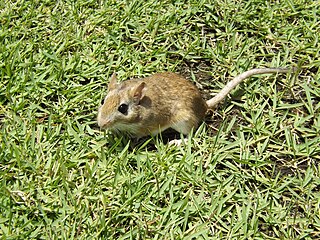
Gerbillinae is one of the subfamilies of the rodent family Muridae and includes the gerbils, jirds, and sand rats. Once known as desert rats, the subfamily includes about 110 species of African, Indian, and Asian rodents, including sand rats and jirds, all of which are adapted to arid habitats. Most are primarily active during the day, making them diurnal, and almost all are omnivorous.

The lesser Egyptian gerbil is a small species of rodent in the family Muridae. It is native to North Africa and the Sinai Peninsula, where it lives in sandy habitats. It is a common species, and the International Union for Conservation of Nature has rated its conservation status as being of "least concern".

The South American gray fox, also known as the Patagonian fox, the chilla or the gray zorro, is a species of Lycalopex, the "false" foxes. It is endemic to the southern part of South America.

The collared tuco-tuco is a tuco-tuco species from South America. It is found in southern Brazil, Uruguay and northern Argentina where it lives underground in a burrow it digs in savannah habitats. It is a relatively common species and the IUCN has assessed its conservation status as being of "least concern".
The dark bolo mouse or dark-furred akodont is a species of rodent in the family Cricetidae. There are two subspecies; one is found in eastern and central parts of Buenos Aires Province, Argentina, and the other in coastal areas of southern Uruguay.
Lemniscomys linulus, commonly known as the Senegal grass mouse or Senegal one-striped grass mouse, is a species of rodent in the family Muridae. It is found in Ivory Coast, Guinea, Mali, and Senegal and its natural habitat is dry savanna. At one time considered to be a subspecies of Lemniscomys griselda, it is now accepted as a species in its own right.
Mittendorf's lemniscomys or Mittendorf's striped grass mouse is a species of rodent in the family Muridae. It is endemic to Cameroon where it is found at high elevations on a single mountain. Its natural habitat is tropical high-altitude grassland. It faces no particular threats and the International Union for Conservation of Nature has listed it as being of "least concern".
The Ethiopian forest brush-furred rat or golden-footed brush-furred rat, is a species of rodent in the family Muridae. It is endemic to Ethiopia where its natural habitat is subtropical or tropical moist montane forests. It is threatened by habitat loss.

Sundevall's jird is a species of rodent in the family of Muridae. It is found in Afghanistan, Algeria, Egypt, Iran, Iraq, Israel, Jordan, Kuwait, Libya, Pakistan, Morocco, Niger, Palestine, Oman, Saudi Arabia, Sudan, Syria, Tunisia, Turkey, Western Sahara, United Arab Emirates, Bahrain and possibly Mali. Its natural habitat is hot deserts.

The Libyan jird is a species of rodent in the family Muridae. It is found in Mauritania, Morocco, Algeria, Tunisia, Libya, Egypt, Jordan, Syria, Saudi Arabia, Iran, Iraq, Afghanistan, Turkmenistan, Uzbekistan, Kazakhstan and Western China. Its natural habitats are subtropical or tropical dry shrubland, intermittent saline lakes, hot deserts, and rural gardens.

The midday jird, also called midday gerbil, is a rodent species in the family Muridae and native to sandy deserts in Central and East Asia. It has been listed on the IUCN Red List as Least Concern since 2008.
Buxton's jird is a species of rodent in the family Muridae. It is found in the Negev desert and the northern coastal parts of the Sinai peninsula.

Tristram's jird is a species of rodent that lives in the Middle East. It is named after the Reverend Henry Baker Tristram who collected the first specimens. It is up to 155 mm (6.1 in) long, and lives in burrows in steppes and semi-deserts from Turkey and the Caucasus to Israel and Iran. Records from the Greek island of Kos represent the only gerbils reported from Europe, outside the former Soviet Union. It is a common, widespread species, and is not considered to be threatened.

Brants's whistling rat or Brants' whistling rat is one of two species of murid rodent in the genus Parotomys. It is found in Botswana, Namibia, and South Africa where its natural habitats are subtropical or tropical dry shrubland and pastureland. It was first described in 1834 by the Scottish zoologist Andrew Smith who named it in honour of the Dutch zoologist and author Anton Brants.

Pseudomys pilligaensis, commonly known as the Pilliga mouse or poolkoo, is a species of rodent in the family Muridae. Its distribution comprises the Pilliga forest region of New South Wales, Australia, specimens have also been trapped in the Warrumbungle National Park and Weetalibah Nature Reserve. Its conservation status is currently listed as "Data Deficient" due to unresolved questions on its taxonomic status.
The gracile tateril or slender gerbil is a species of rodent found in Burkina Faso, Chad, Gambia, Ghana, Guinea, Ivory Coast, Mali, Niger, Nigeria, Senegal, Togo, and possibly Cameroon. Its natural habitats are dry savanna, arable land, pastureland, and rural gardens. It is a common species, sometimes considered an agricultural pest, and the International Union for Conservation of Nature has rated its conservation status as being of "least concern".

The Asian garden dormouse or large-eared garden dormouse, is a species of rodent in the family Gliridae. It is found in Egypt, Iraq, Israel, Jordan, Lebanon, Libya, Saudi Arabia, Syria and Turkey. Its natural habitats are temperate forests, subtropical or tropical dry shrubland, Mediterranean-type shrubby vegetation, rocky areas and gardens.
Kozlov's pygmy jerboa is a species of rodent in the family Dipodidae. It is found in northwestern China and southern and eastern Mongolia. Its natural habitat is temperate desert.












